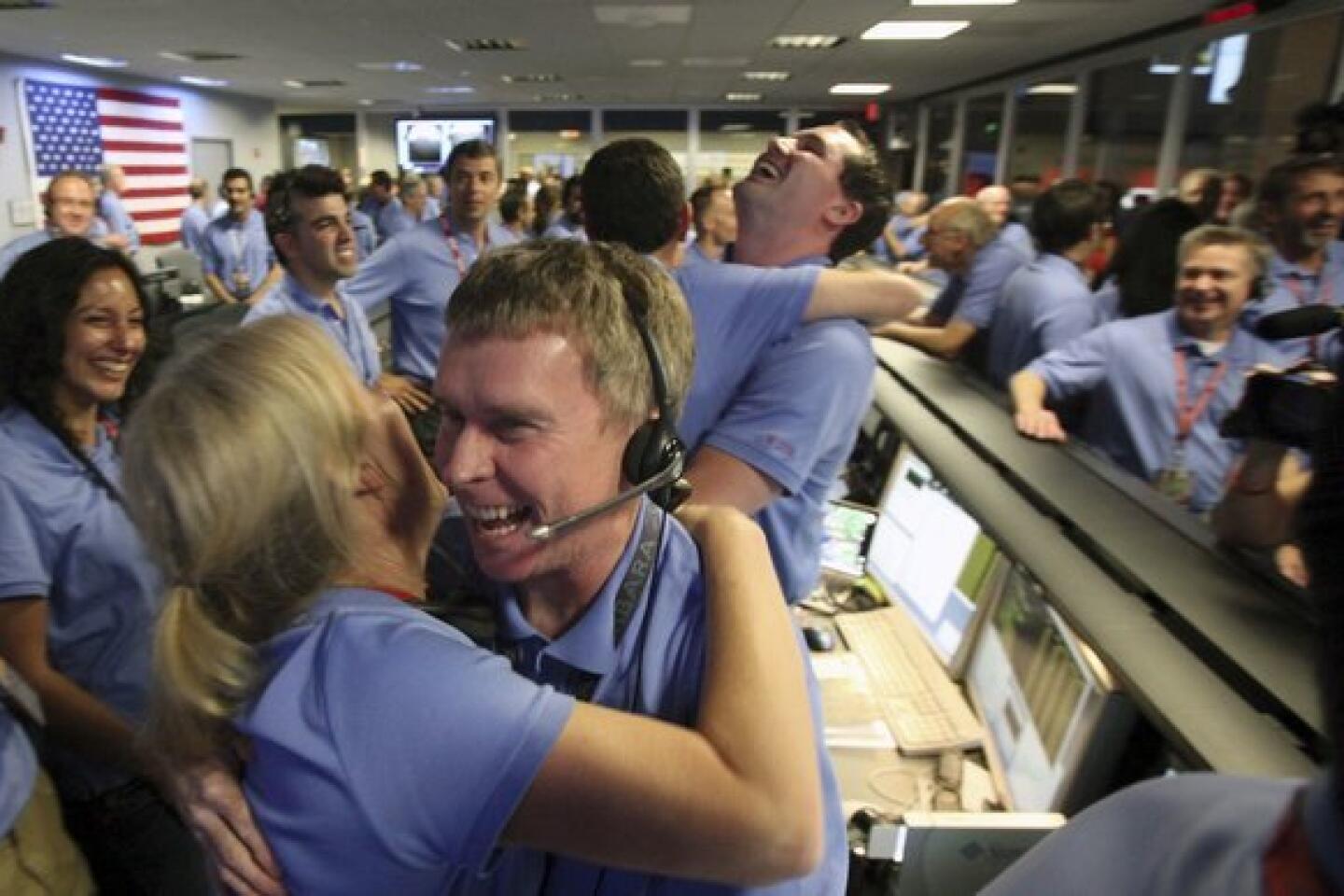JPL scientists hold party to mark Curiosity’s first year on Mars
Listening to NASA employees talk about spacecraft is a lot like listening to a group of parents discuss their children.
“Spitzer turns 10 this year, if anyone wants to cover it,” said Whitney Clavin, press officer for NASA’s Jet Propulsion Laboratory.
Engineers grasping grande cups of coffee scurried in and out of buildings on their way to work. A “Rover Crossing” sign, complete with illustration, sits by a small staircase, a reminder that NASA doesn’t take itself too seriously.
The campus was buzzing over the birthday of Curiosity, the Mars rover that landed one year ago Monday. The star of NASA’s Mars Science Laboratory mission, Curiosity’s mission was to explore the planet’s 3-mile-high Mt. Sharp and to look for signs of past life using the trove of instruments and tools built into its 10-foot-long frame.
To celebrate the landing’s anniversary, JPL held a party, kicked off by a panel discussion in an auditorium full of energetic employees.
Emceed by Chief Scientist Dan McCleese, the presentation recapped the harrowing “Seven Minutes of Terror,” the name given to a video that described the seven minutes from Curiosity’s initial penetration of the Martian atmosphere to its landing.
In only seven minutes, the rover had to slow its 13,000-mph speed, release its heat shield, unfurl a giant parachute, use rockets as brakes once the parachute was cut loose, and finally be deposited gently by cables dangling from a “stage” that would then fly off to avoid colliding with the rover.
That’s a lot that can go wrong, especially when it’s all happening on autopilot.
“At that point, you know it’s out of your hands. You can’t send any commands to the rover,” said Bobak “Mohawk Man” Ferdowsi, whose hairstyle became an Internet meme during the control room broadcast of the landing.
While the control room full of blue-polo-decked engineers and project managers monitored Curiosity’s every move as they came in on a 14-minute time delay, they relinquished command control “a few hours out,” Ferdowsi said.
Allen Chen, who led the control room team during those tense seven minutes and acted as play-by-play announcer for the viewing public, confessed during the panel discussion that for a moment, he thought the mission was doomed.
During Curiosity’s descent, the rover sent signals, or “tones,” every 10 seconds to update mission control on its status, which Chen listened to and decoded.
Shortly after hitting the atmosphere, Curiosity chirped a tone that almost made Chen’s heart stop - it translated to “catastrophic,” implying that the rover was about to fall apart.
“I bet if you go back and rewatch the video, you can see me seize up,” Chen said. “I’m a terrible poker player.”
But Chen wondered whether the message, rather than the rover, was in error: “I thought, ‘Let me sit on this for a minute.’ If we’re about to lose the vehicle, it’s going to become pretty obvious in a minute or two.”
Chen’s calm paid off. Curiosity kept up its descent without incident, and the warning tone ended up being the result of a calibration error, not a problem with the vehicle.
In the year since, Curiosity has been busy. Although it landed in the middle of Gale Crater in order to climb the foothills of nearby Mt. Sharp, once touching down the science team made a decision that “baffled the media,” said John Grotzinger, one of the team’s project scientists.
“We were supposed to be driving toward this mountain, and now we headed off in the opposite direction,” he said.
But Grotzinger knew exactly what he was doing. The team directed its $2.5-billion, six-wheeled space wagon toward Yellowknife Bay, where the rover dug “the drill hole that made history.”
Curiosity is equipped with instruments to analyze Martian dirt, which scientists long suspected held the answer to the question of whether or not the planet was ever hospitable enough for life. Much as Earth’s past climate can be deciphered by examining ancient sediments, subterranean Mars can show what the planet was like billions of years ago, when scientists suspect the atmosphere was much thicker.
After seven months of preparation and deliberation at just the right spot, Curiosity “drilled, looked and Mars turned from red to gray,” Grotzinger said.
The gray color of the soil deep beneath the surface meant that the planet’s iron was reduced - the opposite, oxidized iron, gives Mars its trademark red hue - long ago. Reduced iron means there is a good chance certain microorganisms could have thrived on Mars in the past.
In addition, Curiosity has traversed ancient streambeds, evidence of Mars’ wet past. While all of its water is currently locked up in ice, the planet had liquid water in flood channels and river systems 2 billion years ago, said team scientist Ashwin Vasavada.
So what happened to create the cold red desert of today?
The leading theory, according to Vasavada, is that Mars lost its atmosphere over time. “Mars’ magnetic field went away and made its atmosphere vulnerable to being stripped away by solar wind,” he said.
Following the recap of Curiosity’s first year, JPL employees filed into the Mall, a bright open area near the visitors’ gate where a band played and everyone got free ice cream and models of the rover.
“When we explore, we are asking questions about ourselves,” said Adam Steltzner of the reason more than 1.2 million people watched the landing live online and why the buzz behind Curiosity still hasn’t died down.
“I think one of the reasons this sticks is that this act of exploration is so important to us,” he said. “Through it, we dream a little bigger.”
Follow on Twitter: @BradBalukjian








